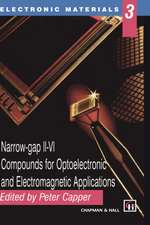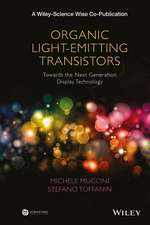Infrared Detectors and Emitters: Materials and Devices: Electronic Materials Series, cartea 8
Editat de Peter Capper, C.T. Elliotten Limba Engleză Hardback – 30 noi 2000
| Toate formatele și edițiile | Preț | Express |
|---|---|---|
| Paperback (1) | 1227.04 lei 6-8 săpt. | |
| Springer Us – 26 feb 2014 | 1227.04 lei 6-8 săpt. | |
| Hardback (1) | 1233.37 lei 6-8 săpt. | |
| Springer Us – 30 noi 2000 | 1233.37 lei 6-8 săpt. |
Preț: 1233.37 lei
Preț vechi: 1504.11 lei
-18% Nou
Puncte Express: 1850
Preț estimativ în valută:
236.00€ • 245.93$ • 195.41£
236.00€ • 245.93$ • 195.41£
Carte tipărită la comandă
Livrare economică 03-17 aprilie
Preluare comenzi: 021 569.72.76
Specificații
ISBN-13: 9780792372066
ISBN-10: 0792372069
Pagini: 478
Ilustrații: XXIX, 478 p.
Dimensiuni: 155 x 235 x 29 mm
Greutate: 0.89 kg
Ediția:2001
Editura: Springer Us
Colecția Springer
Seria Electronic Materials Series
Locul publicării:New York, NY, United States
ISBN-10: 0792372069
Pagini: 478
Ilustrații: XXIX, 478 p.
Dimensiuni: 155 x 235 x 29 mm
Greutate: 0.89 kg
Ediția:2001
Editura: Springer Us
Colecția Springer
Seria Electronic Materials Series
Locul publicării:New York, NY, United States
Public țintă
ResearchCuprins
1 Introduction to Infrared Devices and Fundamentals of their Operation.- 1.1 Introduction.- 1.2 Types of IR detector.- 1.3 Emitters.- References.- 2 Assessment of Infrared Materials and Devices.- 2.1 Introduction.- 2.2 Material Characterization.- 2.3 Device Characterization.- 2.4 Detector Comparisons.- 2.5 Emitter Comparisons.- References.- 3 IV-VI (Lead Chalcogenide) Infrared Sensors and Lasers.- 3.1 Introduction.- 3.2 Some Material Properties.- 3.3 Growth Techniques.- 3.4 Infrared Sensors.- 3.5 Lead Salt Infrared Emitters.- References.- 4 Metal Silicide Schottky Infrared Detector Arrays.- 4.1 Introduction.- 4.2 Internal Photoemission.- 4.3 Silicon Substrate.- 4.4 Platinum Silicide.- 4.5 Cut-off Extension.- 4.6 Pixel Design.- 4.7 PtSi SB FPAs.- 4.8 Summary.- References.- 5 Pyroelectric Materials and Devices.- 5.1 Introduction.- 5.2 The Physics of Pyroelectric Detectors.- 5.3 Pyroelectric Materials and Their Selection.- 5.4 Pyroelectric Thermal Imaging.- 5.5 Pyroelectric Arrays, Design, Technology and Performance.- References.- 6 Uncooled Microbolometer Infrared Sensor Arrays.- 6.1 Introduction.- 6.2 Fabrication of Arrays of Thermal Sensors.- 6.3 Micromachined Microbolometer Design and Fabrication.- 6.4 Temperature-Sensitive Resistor Materials for Microbolometers.- 6.5 Microbolometer Micromachining Sequence.- 6.6 Typical Microbolometer Parameters.- 6.7 Thermal Isolation of Microbolometers.- 6.8 Infrared Absorption in Microbolometers.- 6.9 Readout of Two-dimensional Arrays of Microbolometers.- 6.10 Calculation of the Performance of Bolometer Arrays.- 6.11 Practical Infrared Cameras Using Microbolometer Array.- 6.12 Conclusion.- Acknowledgments.- References.- 7 InSb: Materials and Devices.- 7.1 InSb: the New-Old IR Material.- 7.2 InSb is Different.- 7.3 Purification and Doping.- 7.4 Crystal Growth.- 7.5 Fabrication.- 7.6 Finishing.- 7.7 Useful Techniques.- 7.8 InSb Devices.- References.- 8 Growth, Properties and Infrared Device Characteristics of Strained InAsSb-Based Materials.- 8.1 Introduction.- 8.2 Growth and Characterization of InAsSb by Metal-Organic Chemical Vapor Deposition (MOCVD).- 8.3 Infrared Device Results.- 8.4 Summary and Future Directions.- Acknowledgments.- References.- 9 Tl-Based III-V Alloy Semiconductors.- 9.1 Introduction.- 9.2 Expected Properties of Tl-Based III-V Alloys.- 9.3 Growth Issues.- 9.4 TlInSb on InSb.- 9.5 TuInAs on InAs.- 9.6 T1InP on InP.- 9.7 T1GaP on GaAs.- 9.8 T1GaAs on GaAs.- 9.9 T1InGaP on InP.- 9.10 TlInGaAs on InP.- 9.11 Summary.- References.- 10 MCT Materials Aspects.- 10.1 Introduction.- 10.2 Bulk Growth Techniques.- 10.3 Liquid Phase Epitaxy (LPE).- 10.4 Metal-Organic Vapor Phase Epitaxy (MOVPE).- 10.5 Molecular Beam Epitaxy (MBE).- References.- 11 Photoconductive and Non-equilibrium Devices in HgCdTe and Related Alloys.- 11.1 Introduction.- 11.2 Photoconductive Detectors.- 11.3 Non-equilibrium Devices.- 11.4 Conclusions.- Further Reading.- References.- 12 Photovoltaic Detectors in MCT.- 12.1 Introduction.- 12.2 Historical Perspective on Photovoltaic Detectors in MCT.- 12.3 MCT Hybrid Focal Plane Array Configurations.- 12.4 Principles of Operation and Figures of Merit for MCT PV Detectors.- 12.5 Junction Current Mechanisms for MCT Photodiodes.- 12.6 MCT Junction Photodiode Architectures.- 12.7 Recent Advances in SW and MW MCT Photodiodes.- 12.8 Recent Advances in VLW MCT Photodiodes.- 12.9 Dual-Band MCT Detector Arrays.- 12.10 Summary, Conclusions and Trends.- Acknowledgments.- References.- Appendix A: Guide to the HgCdTe Literature.- 13 Hg-Based Alternatives to MCT.- 13.1 Introduction.- 13.2Crystal Growth.- 13.3 Some Physical Properties.- 13.4 HgZnTe Detectors.- 13.5 HgMnTe Detectors.- 13.6 Conclusions.- References.- 14 Reduced-Dimensionality HgTe-CdTe for the Infrared.- 14.1 Introduction.- 14.2 Energy Bands and Effective Masses.- 14.3 MBE Growth.- 14.4 Absorption, Lifetime, and IR Detectors.- 14.5 Photoluminescence.- 14.6 IR Lasers.- 14.7 Summary.- References.- 15 Quantum Well Infra-red Detectors.- 15.1 Introduction.- 15.2 The QWIP as a Photoconductive Detector.- 15.3 The Microscopic Physics of the QWIP.- 15.4 Performance of AlGaAs/GaAs QWIPs.- 15.5 Optical Coupling Methods.- 15.6 Imaging Arrays.- 15.7 QWIPs in materials other than n-type AlGaAs/GaAs.- 15.8 Conclusions and Future Prospects.- References.
Recenzii
`The book providesa useful, compact reference work for the infrated specialist and a good tutorial for the non-specialist, particularly through the two introductory chapters on the operating principles and assessment of devices, and theoretical sections dispersed amongst the other chapters. Chapters 1 and 2 are recommended reading before full immersion in the later chapters, which are all by well-known.'
Measured Science Technology,12:9(2001)
Measured Science Technology,12:9(2001)













